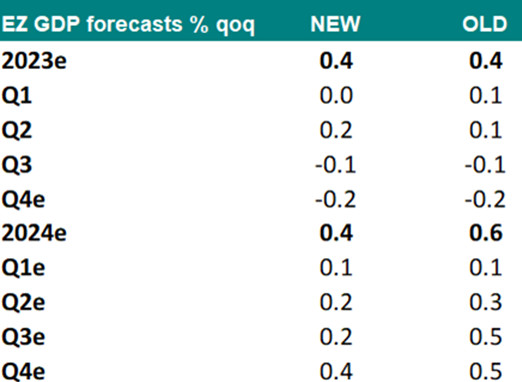Updates to our growth and central bank forecasts

Ahead of our Global Outlook 2024 publication, which will be released in early December, we have made updates to our growth forecasts for the eurozone and US economies, and to our expectations for ECB and Fed policy.
For both central banks, we now expect rate cuts to start one quarter later – in June 2024 rather than our previous March expectation. On the back of this, we have modestly lowered our eurozone growth forecasts. For the US, we have actually upgraded our forecasts, based on data revisions which suggests significantly higher real disposable income and excess savings from the pandemic period. Below we describe our changes in brief; more detail will follow in December.
ECB & Eurozone: Rate cut delay to mean a shallower recovery
We have revised our ECB scenario. Our base case scenario now sees the first rate cut coming in June of next year, rather than March previously. Consequently, we have revised our end 2024 deposit rate forecast to 2.75%, from 2.25% previously. This assumes 25pb cuts at each meeting from June. Finally, we maintain our view that the deposit rate will eventually reach 1.5%, which remains our estimate of neutral.
Macro data continues to point in the direction of the start of a rate cut cycle over the next few months. The economy looks to have entered a moderate recession, which is now clearly resulting in labor market deterioration. Given the monetary tightening which is still to feed through, more weakness lies ahead. Meanwhile, core inflation is on the way down and we judge that this trend has legs. Loosening labour markets will see wage growth decline. Second round effects on the core from lower energy price inflation are still in train.
Despite these trends, we now judge March is probably a bit too early to expect a rate cut. It will take the Governing Council time to form consensus and change its communication.
One could argue that June is too early given President Lagarde’s recent comments ruling out 2024H1 rate cuts. However, like all guidance, we think this is contingent on the ECB’s base scenario. We think that the ECB will be surprised to the downside on both growth and inflation going forward. This will open the door to earlier rate cuts than it currently plans.
Underlying our ECB scenario is that monetary policy is currently very restrictive. We see the neutral rate in the eurozone at around 1.5%, which is in line with a range of academic estimates as well as the manner in which financial conditions and loan demand have reacted to the rate hike cycle.
As financial conditions have tightened more than we thought before and also are expected to remain tighter for longer, due to a later start of interest rate cuts, we have changed our GDP growth forecasts for the eurozone. Specifically, we have lowered our quarterly GDP growth estimates for 2024 Q2-Q4 and now expect a more moderate rebound, with growth staying below the trend rate during most of 2024 (see below). (Nick Kounis & Aline Schuiling)

Fed & US: Later cuts and a higher end point for rates, amid stronger macro fundamentals
We also now expect Fed rate cuts to start in June. While inflation and wage growth have continued to come down in line with expectations, growth has been stronger than expected. This has been driven by a bigger recovery in the supply side than we expected; specifically, labour force participation has now returned to near the pre-pandemic level, while migration flows to the labour force have rebounded sharply. This has enabled the economy to continue growing solidly without inflationary consequences: inflation has continued to move significantly lower, and wage growth is now close to where it was before the pandemic. This is crucial for the inflation outlook, as it significantly lowers the risk that above-target inflation will become entrenched. Our base case continues to be for inflation to fall back to near 2% by the end of 2024.
Alongside the improved supply side, the national accounts data has been revised to show a significant upgrade (+7%) to the estimate of real income per capita. This upward revision also has implications for pandemic excess savings estimates. Previously, it appeared that excess savings were close to being exhausted, while the latest estimates suggest around $1trn in excess savings remaining; still around half the pandemic peak of c$2.2trn.
As a result of these stronger fundamentals, we now expect ultra-tight monetary policy to exert less of a drag on the economy, with growth now expected to slow to around 1% annualised (on average) over Q4 23-Q2 24. In other words, we no longer expect the economy to skirt recession (see table below). While we still see a high chance of a contraction in Q4 on payback for the , we do not expect such contractions to be sustained. There remains some risk of recession, but this is no longer as elevated as we previously thought (this hinges on the Fed normalising rates in a timely manner, as we lay out below). US GDP forecasts (% y/y annual average, quarterly % q/q saar)

Our base case sees the Fed gradually normalising rates from June 2024 onwards, with a 25bp cut at each meeting until the upper bound of the fed funds rate reaches 3%, in July 2025. This end point is 50bp higher than our previous 2.5% expectation. This reflects the stronger fundamentals of the US economy, but also the upside risks to the long-run neutral rate estimate. The neutral rate is impossible to estimate with any precision in real time, but on balance, the risks look tilted towards neutral being somewhat higher rather than lower than the generally assumed 2.5% level. First, the persistently high US government deficit is coming up against reduced demand for liquid safe assets, due to quantitative tightening and stagnant demand from foreign investors (i.e. the global savings glut is not quite the force that it once was). At the same time, while productivity growth is notoriously difficult to forecast, the adoption of new technologies does suggest the risk is tilted to somewhat higher productivity growth than we have grown used to in recent years. More details will follow in our Global Outlook 2024.

